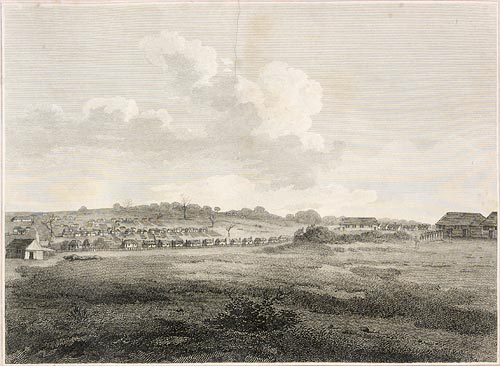Places of Worship
For the first five years church services in the colony were held in the open air or in temporary buildings around Sydney Cove. The settlement's first church was a wattle and daub building built in 1793. Built near the intersection of the present day Hunter and Castlereagh streets, the cost of the building, approximately £67 12s 11½d, was provided by Rev. Richard Johnson. Lieutenant-governor Francis Grose, who succeeeded Phillip, was just as reluctant to provide any funds or labour for an official church. The building was a T-shaped design with a nave 75 feet long by 15 feet. The transepts were 40 feet by 15 feet. The church had a thatched roof and an earthen floor and could seat 500. During the week the building served as a schoolhouse where the Rev. Richard Johnson and his wife, Mary, taught between 150 and 200 children. Johnson was not re-imbursed for the costs until 1797.
A south East View in Sydney, extending from the old to the new Barracks, including the Church, Pitt and Spring Rows, 1798, from An account of the English colony in New South Wales..., by David Collins
Engraving, Q 79/60
Johnson's church was in use until 1798 when allegedly a group of disgruntled convicts burnt down the building in response to Governor Hunter's decree that all residents in the colony including officer and convicts were to attend Sunday services.
After Johnson's church had been burnt down plans were made to build St Phillip's Church on Church Hill (Lang Park). Governor Hunter laid the foundation stone in 1800 but due to building problems the church did not finally open until 1809. The original St Phillip's stone church was replaced in 1857 by the current church designed in the Gothic style by Architect Edmund Blacket.
St. Phillips [ie Philips] Church Sydney, 1809, by John Lewin
Watercolour, PXD 388
Throughout the governorship of Governor Hunter and Macquarie a number of churches were opened or begun. The foundation stone for St James Church was laid in October 1819 and churches were established in Newcastle (1818) , Liverpool (1819), Windsor (1820) and Campbelltown (1823).
In 1836 Governor Bourke introduced The Church Act. By providing government subsidies for land and church construction the Act promoted the building of churches and chapels across the colony. The Act was strongly opposed by members of the Anglican Church, particularly Bishop Broughton, as it formalised government support for the Catholic and Presbyterian churches and weakened the position of the Anglican church in the colony.
The first fifty years of the nineteenth century saw a major increase in church building across the colony. With a combination of government subsidies and private funds churches from a variety of denominations including Baptist, Congregational, Methodist, Catholic, Anglican, Presbyterian established permanent meeting places for their growing congregations.

![St. Phillips [ie Philips] Church Sydney by John Lewin](/archive/images/discover/history_nation/religion/a1313013.jpg)



